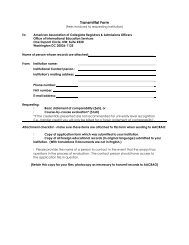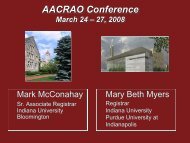document that briefly discusses the rationale - AACRAO
document that briefly discusses the rationale - AACRAO
document that briefly discusses the rationale - AACRAO
You also want an ePaper? Increase the reach of your titles
YUMPU automatically turns print PDFs into web optimized ePapers that Google loves.
<strong>AACRAO</strong> Proposed Bylaws Changes<br />
Rationale Summary & Line Number Reference<br />
March 2013<br />
Routine changes to comply with District of Columbia law and to standardize language are<br />
marked in green in <strong>the</strong> bylaws <strong>document</strong>.<br />
There are two types of changes marked in green: a) those required by recent changes in <strong>the</strong> laws<br />
applicable to non-profit associations incorporated in <strong>the</strong> District of Columbia, and b) changes to<br />
reflect consistency in grammar and language throughout <strong>the</strong> bylaws. We have not listed line<br />
numbers because <strong>the</strong> changes are routine and appear throughout <strong>the</strong> <strong>document</strong>.<br />
The proposed changes in governance are listed below with reference to <strong>the</strong> line numbers<br />
<strong>that</strong> reflect <strong>the</strong> changes in <strong>the</strong> bylaws. These changes are marked in blue.<br />
1) Role of <strong>the</strong> Board Directors<br />
The change proposed articulates <strong>the</strong> role of <strong>the</strong> <strong>AACRAO</strong>’s Board of Directors as more strategic<br />
than programmatic, with a focus on <strong>the</strong> long-term direction of <strong>the</strong> association. It reflects <strong>the</strong><br />
fiduciary responsibility of <strong>the</strong> board.<br />
o Lines 69-92 (94-101)<br />
o Lines 136-138<br />
o Lines 156-161<br />
o Lines 202-203<br />
2) Size and Composition of <strong>the</strong> Board<br />
An increase in <strong>the</strong> number of directors will provide more continuity for <strong>the</strong> board from year to<br />
year. In some years, as few as six directors may continue on <strong>the</strong> board from <strong>the</strong> prior year.<br />
Additional members provide for more effective and robust board committees and a more<br />
manageable workload. Vice presidents at-large provide broader member representation.<br />
• The size of <strong>the</strong> Board is increased to 12-13 directors, including two Vice Presidents atlarge.<br />
o Lines 41-47 (49-52)<br />
o Lines 64-65<br />
3) New Board Position of External Director<br />
Adding an external director provides <strong>the</strong> Board and <strong>the</strong> association with <strong>the</strong> opportunity for a<br />
diversity of perspectives and increased credibility and accountability. The external director will<br />
not be compensated, and members (regular, corporate, or honorary) will not be eligible to serve<br />
as an external director.<br />
• Board may include an External Director<br />
o Lines 45-47<br />
o Line 65<br />
• External Director’s term of service
o Lines 170-173<br />
• External Directors are not eligible to serve on <strong>the</strong> Committee on Nominations and<br />
Elections<br />
o Line 234<br />
• Election of an External Director<br />
o Lines 295-298<br />
4) Election of Member Directors conducted electronically from a competitive slate<br />
Members have requested electronic voting for <strong>the</strong> board so <strong>that</strong> those who cannot attend <strong>the</strong><br />
annual meeting can participate in this governance decision. Offering members a competitive<br />
slate provides more direct participation in governance by <strong>the</strong> general membership.<br />
• Nominations and Elections will develop a competitive slate of nominees for member<br />
directors, consisting of up to twice as many nominees as <strong>the</strong> number of open positions.<br />
o Lines 230-234<br />
o Lines 252-258<br />
o Lines 288-292<br />
• Election of member Directors will be conducted prior to <strong>the</strong> business session of <strong>the</strong><br />
annual meeting, with electronic balloting open to all voting member of <strong>the</strong> association.<br />
o Lines 165-169<br />
o Lines 259-273<br />
o Lines 278-293<br />
o Line 339<br />
o Line 344<br />
• Member Directors will be seated at <strong>the</strong> business session of <strong>the</strong> annual meeting after <strong>the</strong>ir<br />
election.<br />
o Lines 165-169<br />
5) Board member participates in <strong>the</strong> Committee on Nominations and Elections (N&E)<br />
<strong>AACRAO</strong> will be better served by fostering understanding and discussion between <strong>the</strong>se two<br />
groups. Including a non-voting board member on N&E will improve <strong>the</strong> communication between<br />
<strong>the</strong>se important governance bodies, whose members share <strong>the</strong> goal of effective and accountable<br />
governance. It will establish a transparent process for communication, clarifying how<br />
information is shared between <strong>the</strong> committee and <strong>the</strong> board.<br />
• The Committee on Nominations and Elections is expanded to include one board-elected<br />
director each year to serve as a non-voting member.<br />
o Lines 233-235<br />
6) Transition Plan<br />
If <strong>the</strong> changes to <strong>the</strong> bylaws are approved, <strong>the</strong> board will follow a three-year transition plan to<br />
implement <strong>the</strong> changes; this section will be removed automatically once <strong>the</strong> transition is<br />
complete.<br />
o Lines 299-304









